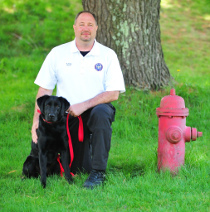An accelerant detection dog should be considered for all large loss residential and commercial structure fires, vehicle fires, incendiary fires and any undetermined fires, according to Michael Koster, fire investigator and owner of Calif. – based Reliant Investigations.
Reliant’s dogs and fire investigators are put through a five week intensive course offered through the Maine State Police K-9 Training Center in Vassalboro, Maine. The facility, located on 200 acres of land, contains a canine agility/confidence course as well as classrooms and a training building.
The dogs are trained according to Pavlov’s theory of classical conditioning. The dogs are trained on a daily basis to recognize odors. Once the dog recognizes the odor it is fed.
“Training has to be daily. These dogs are hand-fed five to seven times a day every day,” Koster said during a presentation on the subject at the Combined Claims Conference in Long Beach, Calif.
Over the course of a year that comes out to about 40,000 repetitions, he said. The dogs are never fed at the same time of day and the amount of food varies. After the first year, the dogs are fed three to five times daily to maintain their skills.
“These dogs have to initially be reviewed on a monthly basis for the first year of their training,” Koster said.
After that, they are reviewed on an annual basis.
“It’s very crucial that the dog is tested, trained and evaluated annually both for the criminal and civil side,” the fire investigator said.
To test the dogs on a daily basis, his investigators use 50 percent evaporated gas. This is based on an ATF study which found the amount of residual gas left over after a building fire was approximately 45 percent.
A small amount of gas is poured into a can twice a day and, according to Koster, the dog will follow the can, sniffing the gas, until it is rewarded with food.

Accelerant detection dogs work approximately five to seven years and they don’t suffer health consequences from the toxic fumes because of their relatively short lifespan.
The dogs are trained to weave in and out of the scent cone until they arrive at the source. Part of the training includes having the dogs identify the source, pass it and return to it.
When a dog finds the source, there is no barking or scratching to alert the investigator. Instead the dog will point to it with its nose. This is to avoid tampering with the scene.
“Always work with passive alerts, never aggressive alerts,” Koster said of the alert system used by accelerant detection dogs.
Koster’s dogs are tested, certified and trained through two different entities. He said t’s very important that a fire investigator validates its accelerant detection dogs.
A major benefit to using an accelerant detection dog on a fire scene is the cost savings.
The dogs are considered more accurate than some devices used today. In addition, because of the increased accuracy, the fire investigator spends less time out on a scene. Lastly, expenses for ruling out samples taken from a scene can be reduced.
Was this article valuable?
Here are more articles you may enjoy.

 OpenAI And Microsoft Sued Over Murder-Suicide Blamed on ChatGPT
OpenAI And Microsoft Sued Over Murder-Suicide Blamed on ChatGPT  California Bill Would Require Insurer Claims Handling Plans, And Double Penalties
California Bill Would Require Insurer Claims Handling Plans, And Double Penalties  NYC Sues Delivery App Over Lost Pay in New Mamdani Crackdown
NYC Sues Delivery App Over Lost Pay in New Mamdani Crackdown  Musk’s xAI Faces California AG Probe Over Grok Sexual Images
Musk’s xAI Faces California AG Probe Over Grok Sexual Images 